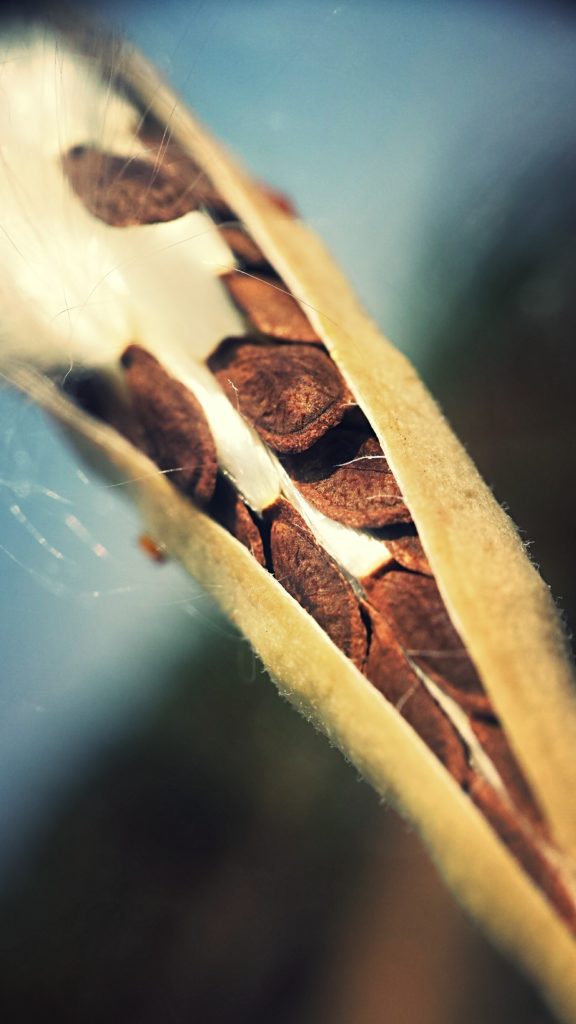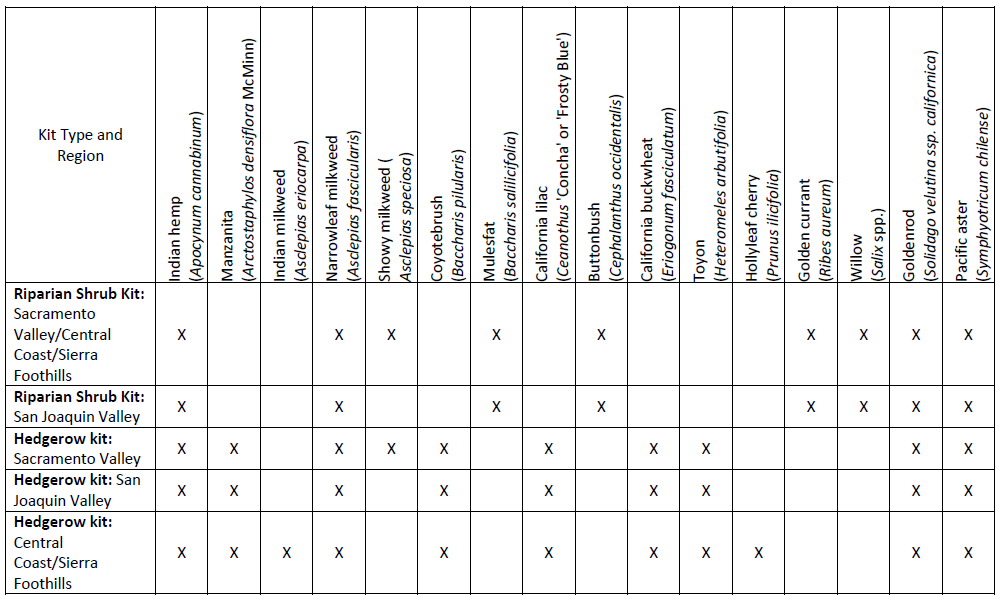APRIL 20, 2020. BY XERCES SOCIETY.
Many insect pollinators are declining in California, including bees and butterflies. The Western monarch population has declined more than 99% since the 1980s, likely due to multiple factors including habitat loss and degradation, pesticides, and climate change. One important step we can take to protect these important animals is to increase the amount of habitat available to these species. To this end, The Xerces Society is offering habitat plant kits that contain climate-smart native plants that support monarchs and other local pollinators in California.
This year, we are offering several different kit types. Please take a minute to look through the different kit descriptions as well as the associated geographic regions, so you can determine which kit would be most appropriate for your project.

A seed pod of the narrow leaf milkweed. (Photo: Charlie Starr IV)
1. Herbaceous Kit. This kit contains 1600 transplants including milkweed and other plants used by monarchs and pollinators. Each kit will cover 0.15 acre (6,400 ft²) if planted on 2 ft. spacing. Minimum order of 1 kit / project. Additional kits can be requested for larger projects.
2. Hedgerow Kit. This kit contains 17 woody and herbaceous plants (including milkweed), which will provide 100 ft of hedgerow when planted on 6 ft spacing. Minimum order of 5 kits / project. Additional kits can be requested for larger projects.
3. Riparian Shrub Kit. This kit contains 17 woody and herbaceous plants (including milkweed), which will provide 100 ft of linear habitat when planted at 6 ft intervals. This kit contains plants that do well in riparian areas and can tolerate some seasonal flooding. Minimum order of 5 kits / project. Additional kits can be requested for larger projects.
4. Riparian Herbaceous Kit. This kit contains 1600 transplants including milkweed and other plants used by monarchs and pollinators. This kit contains plants that do well in riparian areas and can tolerate some seasonal flooding. Each kit will cover 0.15 acre (6,400 ft²) if planted on 2 ft. spacing. Minimum order of 1 kit / project. Additional kits can be requested for larger projects.
(Please note that we are not able to provide partial kits, or smaller quantities per project than listed above. If applying for kits for multiple projects, please fill out a separate application for each project. A note to our RCD partners; Xerces will be counting these acres as part of our Wildlife Conservation Board (WCB) grant deliverables, therefore, RCD’s receiving these kits will not be able to count acres for their own WCB deliverables.)
These kits are intended to be used in public lands or on working lands. Applicants must be able to use the entire kit in one project area but it can be divided up within the area. For example, several plantings within one county park, or several areas on a farm or ranch. The kits are not intended to be used in home gardens or very small project areas. If you have questions about your project’s suitability, email us at centralvalleypollinators@xerces.org.

Monarch butterfly larvae. (Photo: Charlie Starr IV)
There are a number of different kits for different geographic regions of California. These regions include the Central Coast and coastal foothill regions, the Central Valley, and the Sierra Nevada foothill regions. Please note that we do not have kits available for other regions of California. Kits are intended to be used by agencies to create or enhance monarch and pollinator habitat on working lands or natural lands, with landowner or land manager collaboration. The cost of the kit will be covered by Xerces. Recipients are responsible for pick-up of the kits. Shrub kits can be picked up in Chico, CA or Lockeford, CA. Herbaceous kits can be picked up in Winters, CA.
We do not currently have source information on all species, but that information will be included at a later date. It will not be possible to source all seed in the same region(s) that kits are planted, but all species included in each regional kits are native to that region. Kits that are within 5 miles of the coast will not include milkweed, but will have the same total number of plants. For more information on why planting milkweed near the coast is not recommended, please click HERE.
To apply for kits, please complete the application form by May 8, 2020. Applicants will be notified by May 29, 2020. Kits will be available in October of 2020.
Below are the species lists, region information and additional technical information for each kit that will be available. Exact species and numbers are dependent on nursery availability.
Table 1. Tentative plant list for shrub kits (Hedgerow Kits and Riparian Shrub Kits). Kits within 5 miles of the coast will not contain milkweed. Exact species composition dependent on nursery availability. All species will be included as tree-band sized transplants.
Table 2. Tentative plant list for the herbaceous kits (Herbaceous Kits and Riparian Herbaceous Kits). Kits within 5 miles of the coast will not contain milkweed. Kits that include showy milkweed will receive rhizomes of that species. All other species will be included as transplants. Exact species composition dependent on nursery availability.
Counties in each region:
- Sacramento Valley (0-1,000’ elevation): Butte, Colusa, Glenn, Sacramento, Solano, Sutter, Yolo
- San Joaquin Valley (0-1,000’ elevation): Fresno, Kings, Madera, Merced, San Joaquin, Stanislaus, Tulare
- Central Coast: Alameda, Lake, Marin, Monterey, Napa, San Benito, San Francisco, San Mateo, Santa Clara, Santa Cruz, Sonoma
- Sierra Foothills (1,000-4,000’ elevation): Amador, Butte, Calaveras, El Dorado, Fresno, Madera, Mariposa, Nevada, Placer, Tulare, Tuolumne, Yuba
Featured Image: Western monarch (Photo: Stephanie McKnight, Xerces Society)
ABOUT THE XERCES SOCIETY
The Xerces Society is an international nonprofit organization that protects the natural world through the conservation of invertebrates and their habitats. Our name (which is pronounced Zer-sees, or /ˈzɚˌsiz/) comes from the now-extinct Xerces blue butterfly (Glaucopsyche xerces), the first butterfly known to go extinct in North America as a result of human activities. The Xerces blue’s habitat was destroyed by development in the sand dunes of San Francisco, and the species was declared extinct by the 1940s. For nearly 50 years, we have protected endangered species and their habitats, produced ground-breaking publications, trained thousands of farmers and land managers to conserve habitat, and raised awareness about the importance and plights of invertebrates in forests, prairies, deserts, and oceans. Our key program areas are pollinator conservation, endangered species conservation, and reducing pesticide use and impacts.
TO SUBSCRIBE OR DONATE, PLEASE VISIT XERCES.ORG
Have something interesting to say? Consider writing a guest blog article!
To subscribe to the Coffee Shop Blog, send an email to stephanie@lodiwine.com with the subject “blog subscribe.”
To join the Lodi Growers email list, send an email to stephanie@lodiwine.com with the subject “grower email subscribe.”
To receive Lodi Grower news and event promotions by mail, send your contact information to stephanie@lodiwine.com or call 209.367.4727.
For more information on the wines of Lodi, visit the Lodi Winegrape Commission’s consumer website, lodiwine.com.



